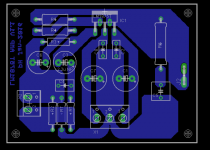Listening to a chipamp's output, you can expect the same subjective effect, but even more pronounced because the load is typically 4-8 ohm, rather than around 32ohm for headphones. That's why I suggested using a classA buffer in order to isolate the SQ change caused by the loading effect on the source. I'm of the belief that classA buffers don't add their own fingerprint on the SQ when implemented optimally.
Thanks, I see your points.
Audio electronics is a new realm for me. I've been many years in digital electronics, since the era of MCS-51.
regards
Audio electronics is a new realm for me. I've been many years in digital electronics, since the era of MCS-51.
regards
Was that based on the 8051? I joined the party perhaps only a little earlier as my first job was programming 8048s 🙂
Yes it's based on intel 8051. In the late 80 and early 90, here in indonesia, mcs-51 was famous mc beside the zilog z80.
@kcray,
about your layout:
I'd recommend that you align your e-caps on one line and also change the positions of the C3 and C6 caps (because the input cap should be further away than the power line, i.e. C7 and C1).
You should also rotate the input terminal by 90° counter-clockwise, then reduce the width of the input line, and finally surround it by the ground line (so as to shield the input line from disturbance).
about your layout:
I'd recommend that you align your e-caps on one line and also change the positions of the C3 and C6 caps (because the input cap should be further away than the power line, i.e. C7 and C1).
You should also rotate the input terminal by 90° counter-clockwise, then reduce the width of the input line, and finally surround it by the ground line (so as to shield the input line from disturbance).
- Status
- Not open for further replies.
- Home
- Amplifiers
- Chip Amps
- My First LM1875 amp
